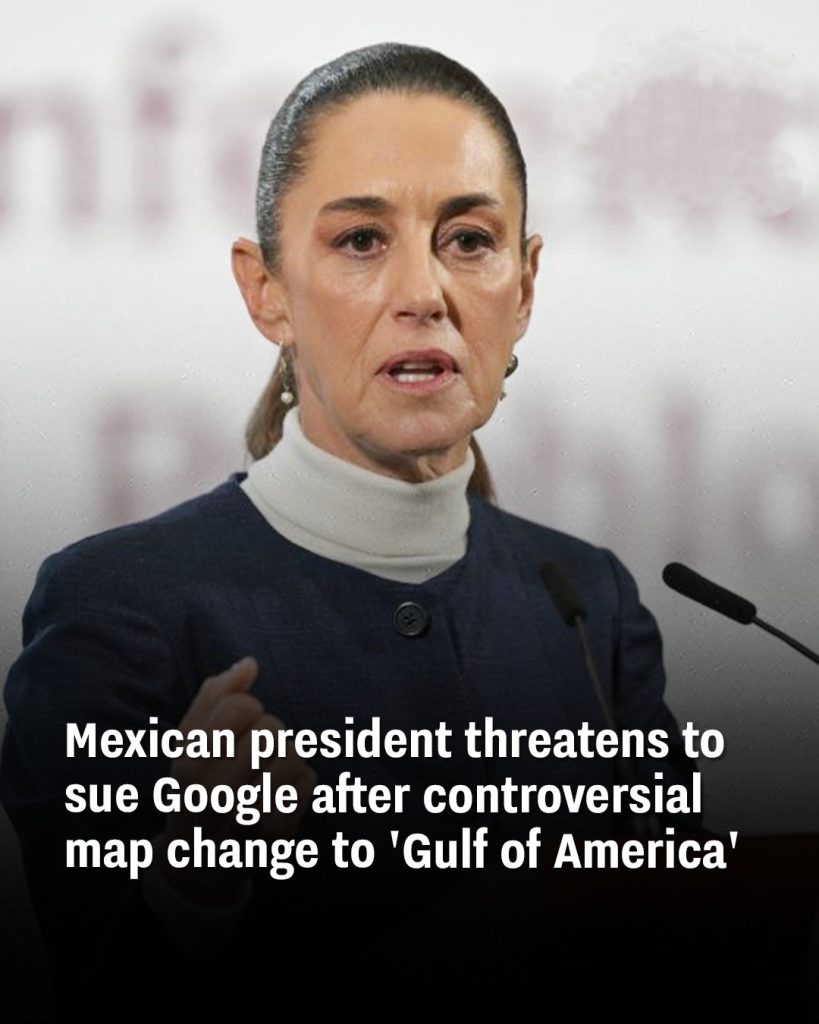In a move that has ignited international debate, Mexican President Claudia Sheinbaum has threatened legal action against Google following the company’s decision to rename the “Gulf of Mexico” to the “Gulf of America” on its mapping services for U.S. users. This change aligns with an executive order signed by U.S. President Donald Trump shortly after his inauguration on January 20, 2025.
The Executive Order and Its Implications
President Trump’s executive order, titled “Restoring Names That Honor American Greatness,” mandates the renaming of several geographical landmarks, including the Gulf of Mexico and Alaska’s Denali mountain, which is to revert to its former name, Mount McKinley. The order asserts that these changes are intended to “honor American heroes” and “restore American pride in the history of American greatness.” The directive specifies that the “Gulf of America” designation applies to the U.S. continental shelf area, bounded by the states of Texas, Louisiana, Mississippi, Alabama, and Florida, extending to the seaward boundaries with Mexico and Cuba.
Google’s Compliance and Mexico’s Response
In response to the executive order, Google updated its Maps service to reflect the new naming conventions. For users within the United States, the body of water previously known as the Gulf of Mexico now appears as the Gulf of America. In Mexico, the original name remains, while users in other countries see both names displayed. Google stated that its naming decisions follow official government sources and that it has a longstanding practice of applying name changes when updated in such sources.
President Sheinbaum has strongly criticized this change, arguing that the U.S. government does not have the authority to unilaterally rename a body of water that is internationally recognized and shared by multiple nations. She emphasized that the Gulf of Mexico has been known by its current name since the 16th century and that any attempt to rename it infringes upon Mexico’s sovereignty. Sheinbaum has formally requested that Google revert to the original name on its platform and has indicated that Mexico may pursue legal action if the company does not comply.
International and Domestic Reactions
The renaming has sparked a range of reactions both within the United States and internationally. In the U.S., media organizations have taken varied stances. The Associated Press announced that it would continue to use “Gulf of Mexico” in its reports, leading to tensions with the White House. As a result, AP reporters were barred from certain press events, a move that has been criticized as a violation of press freedom.
Within the technology sector, other companies have also responded to the executive order. Apple and Microsoft have updated their mapping services to reflect the new names, while some organizations have chosen to retain the original nomenclature, highlighting the divisive nature of the directive.
Historical Context and Sovereignty Issues
The Gulf of Mexico has been recognized by its current name since the early 16th century, a testament to its long-standing historical and cultural significance. The body of water is bordered by the United States, Mexico, and Cuba, with each nation exercising jurisdiction over its respective territorial waters. International law, as outlined in the United Nations Convention on the Law of the Sea, dictates that a nation’s sovereignty extends up to 12 nautical miles from its coastline. Beyond this limit, waters are considered international, and unilateral renaming by a single nation is not typically recognized.
President Sheinbaum has underscored this point, stating that while the U.S. may choose to rename the portion of the gulf within its territorial waters, extending this change to the entire body infringes upon the rights and sovereignty of other bordering nations. She has called for international recognition of the gulf’s historical name and has urged multinational corporations like Google to respect established geographical nomenclature.
Potential Legal and Diplomatic Ramifications
The threat of legal action by Mexico introduces a complex layer to the situation, potentially setting a precedent for how digital platforms handle geographical names subject to political disputes. If Mexico proceeds with a lawsuit, it could lead to a protracted legal battle over the responsibilities and obligations of global tech companies in navigating international naming conventions.
Diplomatically, this controversy may strain relations between the United States and Mexico. The renaming, coupled with other policy decisions by the Trump administration, such as proposed tariffs on Mexican goods and immigration policies, contributes to an atmosphere of tension and uncertainty. How both nations navigate this dispute could have lasting implications for their bilateral relationship and for international protocols regarding shared natural resources.
Conclusion
The renaming of the Gulf of Mexico to the Gulf of America, as mandated by a U.S. executive order and implemented by companies like Google, has sparked significant controversy and debate. Mexico’s strong opposition, grounded in historical precedent and concerns over national sovereignty, highlights the complexities inherent in unilateral geographical renaming. As this situation unfolds, it underscores the delicate balance between national policies, international relations, and the global responsibilities of technology platforms.



